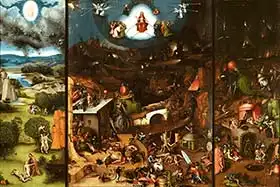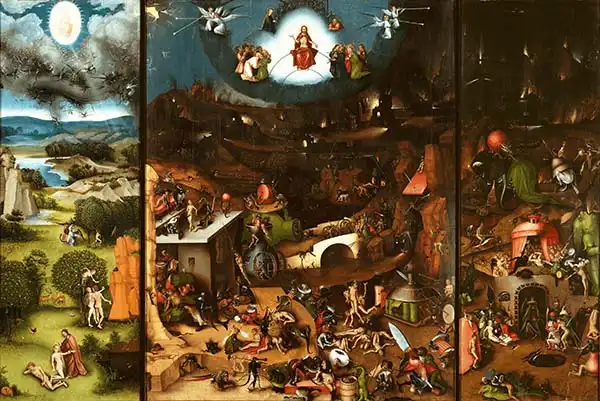About this finishing
Print. The image is printed on the top quality 10-ink HP Z9PS printer on HP matte 270 g / m2 paper. You can choose any size to an accuracy of 1 cm. A margin of 5 cm around the image is added to the size of the motif.


You can find a detailed description about our finishings
here.
The Last Judgment
Date:
1482 - 1516Medium:
oil on boardLocation:
Academy of Fine Art, VídeňDimensions:
163.7 x 247Hieronymus Bosch's "The Last Judgment" is a masterpiece of medieval art that provokes and inspires viewers with its visionary essence and complex symbolism.
The painting is divided into two main parts. The upper part shows heaven and Jesus Christ as judge, enthroned and holding a cross, referring to his sacrifice for the sins of mankind. Around him are angels and saints. While the lower part is hell which is crowded with various demons, monstrous creatures and humans. People are depicted in various situations, suffering for their sins. Bosch became famous for his detailed and often bizarre depictions of the torments of hell.
"The Last Judgment" is full of symbolism associated with the medieval Christian faith and moral message. The painting emphasizes the consequences of sin and the need for salvation, creating an atmosphere of fear, tension and hope. The depiction of the judge and hell evokes different emotions and impressions in the viewer.
Bosch painted picture The Last Judgment in 1482 - 1516. Prevailing color of this fine art print is brown and its shape is landscape. Original size is 163.7 x 247. This art piece is located in Academy of Fine Art, Vídeň. This image is printed on demand - you can choose material, size and finishing.
Hieronymus Bosch (1450 -1516). Dutch painter whose real name is Jheronimus van Aken (his name is derived from the city s-Hertogenbosch). He came from a family of painters - his grandfather and uncles were all painters. Much of his work is devoted to sin and human moral failure. Bosch painted demons, half-human creatures, to evoke fear and unearth the evil hidden in man. He became famous mainly for his triptychs (the most famous is the
Garden of Earthly Delights. He was the first who created and worked with the world of dreams, fantasy creatures, nightmares and fears, as a response to former medieval religious ideas (about
deadly sins, a naturally sinful humanity, hell and eternal damnation).


